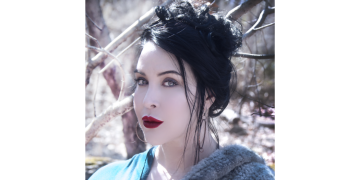Like the book, the dance proceeds as a series of episodes. Roche seems to have selected a handful of Joyce’s 18 sections, interpreting some more literally than others, and establishing certain gestural motifs that lend a sense of cohesion. Perhaps the most recurrent and laden with meaning — at times a bit too heavily — is a hand at the heart, cupped or with fingers blooming upward, paired with pulsations of the chest.
In one episode, Yusuf walks onstage and pulls a synthetic heart from under his shirt, offering it to the angelic Cuny. Roche is judicious in her choice of when to supply language, and how much. The following passage is one of just a few that appear projected on the screen:
“Broken heart. A pump after all, pumping thousands of gallons of blood every day. One fine day it gets bunged up: and there you are. Lots of them lying around here: lungs, hearts, livers. Old rusty pumps: damn the thing else. The resurrection and the life.”
In the vigorous dancing that follows — under Davison Scandrett’s deep red lighting, and backed by a slow cascade of religious images — the performers could be a pumping heart themselves, four chambers that begin in harmony and ultimately fracture, until only Yusuf is left, lying face down on the floor. (Cerneaux returns for something like a grieving ritual, maybe a resurrection.) At other times, the dancers pat their torsos, as if trying to locate their internal organs.
Given Roche’s artistic medium, the body, it makes sense that she would lean into this corporeal imagery. From a source known for its alienating qualities, she wrings feeling and humanity. She also embraces themes of eroticism, especially in the climactic penultimate episode, when all of the dancers, anonymized in floral-patterned body suits and face coverings, entangle in lustful and violent poses. (Katie Davenport did the costume and stage design.) There’s humor here, too, the interactions goofier than they are gritty.






















